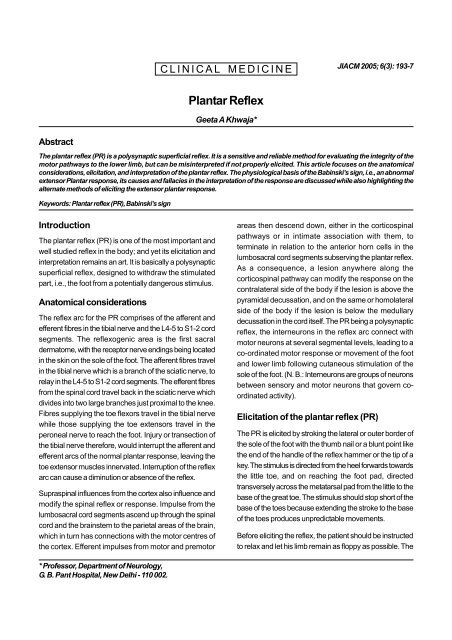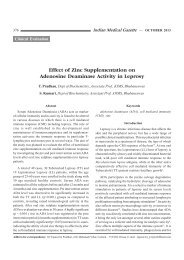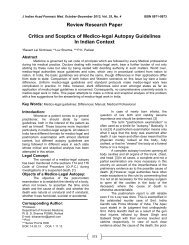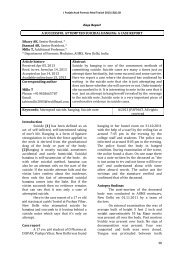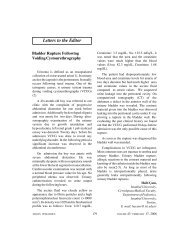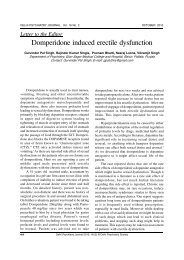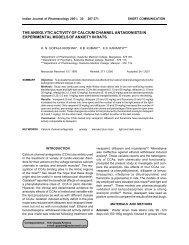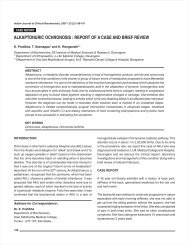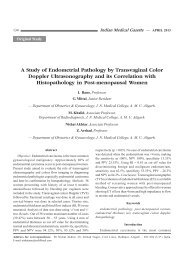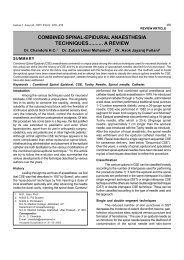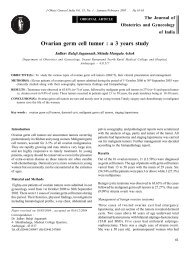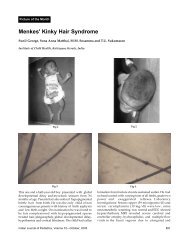You also want an ePaper? Increase the reach of your titles
YUMPU automatically turns print PDFs into web optimized ePapers that Google loves.
CLINICAL MEDICINE<br />
JIACM 2005; 6(3): 193-7<br />
<strong>Plantar</strong> <strong>Reflex</strong><br />
Geeta A Khwaja*<br />
Abstract<br />
The plantar reflex (PR) is a polysynaptic superficial reflex. It is a sensitive and reliable method for evaluating the integrity of the<br />
motor pathways to the lower limb, but can be misinterpreted if not properly elicited. This article focuses on the anatomical<br />
considerations, elicitation, and interpretation of the plantar reflex. The physiological basis of the Babinski’s sign, i.e., an abnormal<br />
extensor <strong>Plantar</strong> response, its causes and fallacies in the interpretation of the response are discussed while also highlighting the<br />
alternate methods of eliciting the extensor plantar response.<br />
Keywords: <strong>Plantar</strong> reflex (PR), Babinski’s sign<br />
Introduction<br />
The plantar reflex (PR) is one of the most important and<br />
well studied reflex in the body; and yet its elicitation and<br />
interpretation remains an art. It is basically a polysynaptic<br />
superficial reflex, designed to withdraw the stimulated<br />
part, i.e., the foot from a potentially dangerous stimulus.<br />
Anatomical considerations<br />
The reflex arc for the PR comprises of the afferent and<br />
efferent fibres in the tibial nerve and the L4-5 to S1-2 cord<br />
segments. The reflexogenic area is the first sacral<br />
dermatome, with the receptor nerve endings being located<br />
in the skin on the sole of the foot. The afferent fibres travel<br />
in the tibial nerve which is a branch of the sciatic nerve, to<br />
relay in the L4-5 to S1-2 cord segments. The efferent fibres<br />
from the spinal cord travel back in the sciatic nerve which<br />
divides into two large branches just proximal to the knee.<br />
Fibres supplying the toe flexors travel in the tibial nerve<br />
while those supplying the toe extensors travel in the<br />
peroneal nerve to reach the foot. Injury or transection of<br />
the tibial nerve therefore, would interrupt the afferent and<br />
efferent arcs of the normal plantar response, leaving the<br />
toe extensor muscles innervated. Interruption of the reflex<br />
arc can cause a diminution or absence of the reflex.<br />
Supraspinal influences from the cortex also influence and<br />
modify the spinal reflex or response. Impulse from the<br />
lumbosacral cord segments ascend up through the spinal<br />
cord and the brainstem to the parietal areas of the brain,<br />
which in turn has connections with the motor centres of<br />
the cortex. Efferent impulses from motor and premotor<br />
areas then descend down, either in the corticospinal<br />
pathways or in intimate association with them, to<br />
terminate in relation to the anterior horn cells in the<br />
lumbosacral cord segments subserving the plantar reflex.<br />
As a consequence, a lesion anywhere along the<br />
corticospinal pathway can modify the response on the<br />
contralateral side of the body if the lesion is above the<br />
pyramidal decussation, and on the same or homolateral<br />
side of the body if the lesion is below the medullary<br />
decussation in the cord itself. The PR being a polysynaptic<br />
reflex, the interneurons in the reflex arc connect with<br />
motor neurons at several segmental levels, leading to a<br />
co-ordinated motor response or movement of the foot<br />
and lower limb following cutaneous stimulation of the<br />
sole of the foot. (N. B.: Interneurons are groups of neurons<br />
between sensory and motor neurons that govern coordinated<br />
activity).<br />
Elicitation of the plantar reflex (PR)<br />
The PR is elicited by stroking the lateral or outer border of<br />
the sole of the foot with the thumb nail or a blunt point like<br />
the end of the handle of the reflex hammer or the tip of a<br />
key. The stimulus is directed from the heel forwards towards<br />
the little toe, and on reaching the foot pad, directed<br />
transversely across the metatarsal pad from the little to the<br />
base of the great toe. The stimulus should stop short of the<br />
base of the toes because extending the stroke to the base<br />
of the toes produces unpredictable movements.<br />
Before eliciting the reflex, the patient should be instructed<br />
to relax and let his limb remain as floppy as possible. The<br />
* Professor, Department of Neurology,<br />
G. B. Pant Hospital, New Delhi - 110 002.
leg should be positioned in such a way that the knee is<br />
straight or slightly flexed and the thigh externally rotated.<br />
It is important to distract the patient with conversation after<br />
warning him that the sole of the foot will be scratched. It is<br />
advisable to hold the patient’s ankle with one hand, to keep<br />
the foot in place and control the pressure of the plantar<br />
stroke. The stimulus should be firm, gentle and should cause<br />
neither pain nor tickle. A sharp stimulus is applied only if<br />
the initial stimulus fails to elicit a response. The response<br />
can be reinforced by rotation of the patient’s head to the<br />
opposite side. Following the stimulus, it is important to<br />
watch the big toe at the metatarsophalangeal joint and the<br />
remainder of the foot. The response usually occurs after<br />
the plantar stroke has moved a few centimeters along the<br />
sole to produce a spatial and temporal summation of the<br />
applied stimulus.<br />
Interpretation of the response<br />
The plantar response may be:<br />
1. Normal flexor plantar response<br />
2. Pathologic or abnormal extensor plantar response<br />
(Babinski’s sign)<br />
Normal flexor plantar response<br />
In normal people after infancy, there is a plantar flexion of<br />
the foot and toes along with adduction of the toes. The<br />
primary movement is a plantar flexion of the great toe at<br />
the metatarsophalangeal joint, even if the terminal joint<br />
appears to extend. The response is a fairly rapid one and<br />
may be accompanied at times by an associated flexion of<br />
the hip and knee on the stimulated side.<br />
Abnormal extensor plantar response<br />
(Babinski’s sign)<br />
Joseph Babinski, a French neurologist, first differentiated<br />
between a normal and a pathologic plantar response and<br />
described the Babinski sign in 1896. The Babinski’s sign is<br />
encountered in patients with pyramidal tract dysfunction<br />
and is characterised by a dorsiflexion or extension of the<br />
great toe with or without fanning or abduction of the<br />
other toes. The fully developed response is also<br />
accompanied by dorsiflexion of the ankle and flexion of<br />
the hip and knee joint and slight abduction of the thigh,<br />
leading to a withdrawal of the leg on plantar stimulation.<br />
The Babinski sign is always pathological. There is no such<br />
thing as a negative Babinski sign.<br />
The muscles taking part in a fully developed response<br />
include the extensor hallucis longus, tibialis anterior,<br />
extensor digitorum longus, hamstring group of muscles,<br />
and the tensor fasciae latae. The dorsiflexion of the toes<br />
may be the only visible effect, but the contraction of the<br />
thigh and leg muscles is always present and can be<br />
detected by palpation. Contraction of the tensor fasciae<br />
latae has been referred to as Brissaud’s reflex.<br />
The fully developed extensor plantar response forms part<br />
of the primitive ‘flexion reflex synergy’ of the lower limbs<br />
designed to withdraw the limb from a painful stimulus.<br />
This spinal defence reflex mechanism described by<br />
Sherrington, activates all the muscles involved in<br />
shortening the stimulated limb. It involves flexion of the<br />
hip and knee, dorsiflexion of the ankle and extension of<br />
the great toe. The ‘toe and foot extensors’ although named<br />
extensors by anatomists, are in fact flexor in a physiological<br />
sense, because their action is to shorten the limb and<br />
contract reflexly alongwith other flexor muscles. The<br />
physiologist looks on the Babinski sign as simply a part of<br />
the ‘primitive flexion reflex’.<br />
The Babinski sign may be a normal occurrence in the first<br />
year of life. In the infant, before myelination of the nervous<br />
system is complete and an upright stance has been<br />
achieved, the normal plantar response is extensor, due to a<br />
brisker ‘flexion synergy’ as part of the withdrawal response<br />
to pain. As the nervous system matures and the pyramidal<br />
tracts gain more control over spinal motor neurons, the<br />
‘flexion synergy’ becomes less brisk and the toe ‘extensors’<br />
are no longer a part of it. When the child assumes an upright<br />
posture, the plantar response becomes part of the postural<br />
reflex maintaining the tones of the foot and leg. At this time,<br />
the normal response to stimulation becomes a flexor<br />
movement of the toes and the ‘withdrawal extensor’<br />
movement is suppressed by the influence of the pyramidal<br />
tract over the spinal reflex arc. The toe then goes down<br />
instead of up, as a result of a segmental reflex involving<br />
small foot muscles and the overlying skin.<br />
The pyramidal tract thus maintains a suppressor action<br />
on the ‘flexion reflex’ synergy. Pyramidal tract dysfunction<br />
however, allows the response to revert to the primitive<br />
194 Journal, Indian Academy of Clinical Medicine Vol. 6, No. 3 July-September, 2005
withdrawal movement by releasing or facilitating the<br />
‘flexion reflex synergy’ of which contraction of the<br />
extensor hallucis longus muscle forms an integral part. A<br />
Babinski sign can appear only if the intraspinal pathways<br />
of the ‘flexion reflex synergy’ are operative, however severe<br />
the motor deficit in the foot. The motor neurons of the<br />
leg muscles are laminated into separate columns within<br />
the anterior horns of the cord, each of which supply<br />
proximal or distal flexor or extensor muscles. Both<br />
structural as well as functional lesions of the pyramidal<br />
tract fibres projecting onto the lumbosacral anterior horn<br />
cells and interneurons supplying the leg muscles<br />
subserving the ‘flexion reflex synergy’ can release the<br />
Babinski sign. Reversible pathophysiologic conditions<br />
result in, or produce, a transient extensor plantar response.<br />
Structural lesions produce more lasting effects.<br />
Causes of an extensor plantar response<br />
<br />
<br />
<br />
<br />
<br />
<br />
<br />
<br />
<br />
<br />
<br />
<br />
<br />
Pyramidal tract lesions<br />
Normal children upto one year of age<br />
Deep sleep<br />
Coma<br />
General Anaesthesia<br />
Post-ictal stage of epilepsy<br />
Electroconvulsive therapy (ECT)<br />
Hypoglycaemia<br />
Alchol intoxication<br />
Narcosis<br />
Hypnosis<br />
Following severe physical exhaustion<br />
Head trauma with concussion.<br />
Types of Babinski sign<br />
<br />
<br />
<br />
True Babinski sign – includes all the components of<br />
the fully developed extensor plantar response.<br />
Minimal Babinski sign – is characterised by<br />
contraction of the hamstring muscles and the tensor<br />
fasciae latae which can be detected by palpation of<br />
the thigh.<br />
Spontaneous Babinski sign – is encountered in<br />
patients with extensive pyramidal tract lesions. Passive<br />
flexion of the hip and knee or passive extension of the<br />
<br />
<br />
<br />
knee may produce a positive Babinski sign in adults, as<br />
may foot manipulation in infants and children.<br />
Crossed extensor response/bilateral Babinski sign<br />
– may be encountered in cases with bilateral cerebral<br />
or spinal cord disease. Unilateral foot stimulation<br />
elicits a bilateral response in such cases.<br />
Tonic Babinski reflex – is characterised by a slow<br />
prolonged contraction of the toe extensors. It is<br />
encountered in patients with combined frontal lobe<br />
lesions and extrapyramidal involvement.<br />
Exaggerated Babinski sign – may take the form of<br />
a flexor or extensor spasm. Flexor spasms can occur<br />
in patients with bilateral UMN lesion at the supraspinal<br />
or spinal cord level. Extensor spasms can occur in<br />
patients with bilateral corticospinal tract lesion but<br />
preserved posterior column function.<br />
Babinski mimickers<br />
<br />
<br />
<br />
Pseudo Babinski sign<br />
Inversion of plantar reflex<br />
Withdrawal response<br />
Pseudo Babinski sign<br />
This sign may be encountered in patients with<br />
choreoathetosis where the upgoing toe is a manifestation<br />
of hyperkinesia.<br />
Inversion of the plantar reflex<br />
If the short flexors of the toe are paralysed, or the flexor<br />
tendons have been severed, an extensor plantar response<br />
may be obtained even in the absence of UMN lesions and<br />
is termed inversion of the plantar reflex of peripheral<br />
origin.<br />
Withdrawal response<br />
Most people tend to withdraw their feet from a plantar<br />
stimulus as they are unable to tolerate the sensation. This<br />
reflex withdrawal interferes with the normal response. It<br />
is basically a voluntary movement or withdrawal due to a<br />
ticklish or unpleasant sensation. It is encountered in<br />
sensitive individuals or patients with plantar<br />
hyperaesthesia due to peripheral neuritis, and can be<br />
Journal, Indian Academy of Clinical Medicine Vol. 6, No. 3 July-September, 2005 195
confused with a positive Babinski’s sign. It is characterised<br />
by a dorsiflexion of the ankle alongwith hip and knee<br />
flexion. In such a situation, it is important to repeat the<br />
stimulus more gently and hold the foot at the ankle, or try<br />
alternative stimuli. A true Babinski sign can be clinically<br />
distinguished from the false Babinski by a failure to inhibit<br />
the extensor response by pressure over the base of the<br />
great toe. Moreover, unlike the voluntary withdrawal of<br />
the toes, the true Babinski sign is reproducible.<br />
<br />
movement of the big toe. The toe could be so retracted<br />
as to appear to be in the extensor position to start with.<br />
In such a situation, it is important to observe the<br />
movement at the metatarsophalangeal joint because<br />
if the terminal joint alone is observed, a further<br />
extension of the same may be quite misleading.<br />
An equivocal response is sometimes observed and is<br />
difficult to interpret.<br />
Fallacies in the interpretation of the plantar<br />
response<br />
<br />
<br />
<br />
<br />
<br />
No response to the plantar stimulus may be observed<br />
in certain situations. Patients with callosities of the feet<br />
may be unable to feel the plantar sensation. Sensory<br />
loss in the S1 dermatome may be encountered in<br />
patients with peripheral neuropathy or tibial nerve<br />
injury and it interferes with the afferent limb of the<br />
reflex arc leading to an absence of the reflex.<br />
Cases with proven damage to the pyramidal system<br />
may have a normal plantar response. The possible<br />
explanation for this is that corticospinal fibres not only<br />
originate in different parts of the cortex, but also have<br />
different terminations. Babinski sign can be expected<br />
only when the leg fibres of the pyramidal tract are<br />
involved.<br />
An extensor plantar response may be obtained in the<br />
absence of damage to the pyramidal tract due to<br />
possible dissociation of the nerve fibres in the spinal<br />
reflex arc, with excitation of the distal motor neurons<br />
and inhibition of the impulses via flexor reflex afferent<br />
nerve fibres, since they are mediated by different<br />
neurons.<br />
Babinski response may not be observed in UMN lesions<br />
with complete paralysis of the extensors of the toes.<br />
The toes are unable to extend due to a total paralysis<br />
of the muscles. In such cases, contraction of the tensor<br />
fasciae latae may be taken as a positive sign.<br />
Bony deformities like ‘hallux valgus’ may prevent any<br />
movement of the big toe. In such a situation it is<br />
important to observe the movement of the other toes.<br />
Role of videotape and EMG in the<br />
interpretation of the <strong>Plantar</strong> Response<br />
A positive Babinski sign is confirmed if:<br />
<br />
<br />
The upward movement of the great toe is caused by<br />
contraction of the extensor hallucis longus muscle<br />
(EHL).<br />
Contraction of the EHL occurs synchronously or<br />
concurrently with reflex activity in other flexor<br />
muscles that may or may not be brisk enough to be<br />
appreciated visually.<br />
Videotaping and EMG can thus aid the clinical<br />
interpretation in patients with unexpected finding or<br />
an equivocal response.<br />
Alternate methods to elicit the extensor<br />
plantar response<br />
The method of Babinski is probably the most sensitive and<br />
reliable method for elicitation of the plantar reflex, but<br />
may at times fail to do so or produce an equivocal<br />
response. Other methods can then be used to elicit the<br />
response and include some of following techniques:<br />
<br />
<br />
<br />
<br />
Chaddock’s sign: The stimulus is applied along the<br />
lateral aspect of the foot, below the external malleolus.<br />
Oppenheim’s reflex: Firm pressure is applied along<br />
the shin of the tibia from below the knee upto the<br />
ankle with the knuckles of the examiner’s index and<br />
middle finger.<br />
Gordan’s sign: The calf muscle is squeezed.<br />
Schaefer’s sign: Squeezing the Achilles tendon.<br />
<br />
In patients with ‘pes cavus’ it is difficult to assess the<br />
<br />
Gonda’s sign: The fourth toe is pressed downwards<br />
196 Journal, Indian Academy of Clinical Medicine Vol. 6, No. 3 July-September, 2005
and then released with a snap.<br />
Stransky sign: The fourth toe is abducted maximally<br />
and then released suddenly.<br />
Bing’s sign: Multiple pinpricks are given on the<br />
dorsolateral surface of the foot.<br />
Moniz sign: The ankle is forcefully plantar flexed and<br />
then released.<br />
Thockmorton sign: The dorsal aspect of the<br />
metatarsophalangeal joint of the great toe is<br />
percussed.<br />
University press 1989. The <strong>Reflex</strong>es. Chapter 25, pg. 179 to<br />
195.<br />
2. Kumar SP, Ramasubramanian D. The Babinski sign – A<br />
reappraisal. Neurology India 2000; 48: 314 -8.<br />
3. Mayo Clinic. Clinical Examination in Neurology. Asian<br />
edition. Fourth edition. W.B. Saunders company, 1976;<br />
<strong>Reflex</strong>es. Chapter 8, pg 169-80.<br />
4. Dejong’s: The neurologic examination. Revised by AF Haerer.<br />
Fifth edition. Lippincat Raven 1992. Corticospinal (pyramidal<br />
tract) responses. Chapter 35 pg. 453 to 64.<br />
5. Willam E, De Myer. The technique of the neurologic<br />
examination. Fifth edition 2004. Chapter 7. Examination<br />
of the somatic motor system (excluding cranial nerve), pg<br />
277-370.<br />
<br />
<br />
Strumpell sign: Forceful pressure is applied over the<br />
anterial tibial region.<br />
Cornell sign: The dorsum of the foot is scratched<br />
along the inner side of the extensor tendon of the<br />
great toe.<br />
Most of these signs imply an increase in the reflexogenous<br />
zone and denote responses from different parts of the<br />
receptive field. When sufficiently facilitated, the reflex may<br />
be elicited by other stimuli as well. Infact, in extreme cases<br />
of UMN deficit, the complete ‘flexion reflex’ may be<br />
exhibited spontaneously and continuously; the patient lies<br />
in bed, the hip and knee flexed, and the ankle and great<br />
toe dorsiflexed. In other cases of severe UMN deficit,<br />
almost any unpleasant stimulus, such as scratching,<br />
pinching, or pricking, will evoke the ‘flexion reflex’, even<br />
when applied as high as the thigh, far from the usual<br />
reflexogenous zone.<br />
In conclusion, the plantar reflex (and the Babinski sign) is<br />
a sensitive and reliable method for evaluating the integrity<br />
of the nervous system and motor pathways to the lower<br />
limbs. Historically, unknown to Babinski, several painters<br />
like Bortticelli, Rapheal, and Leonardo da Vinci had already<br />
demonstrated this phenomenon in their paintings,<br />
thereby blending art with science. Even though its<br />
elicitation is an art and observer bias may occur with<br />
regards to its interpretation, its clinical utility remains<br />
unchallenged.<br />
References<br />
1. Bickerstaff ER, Spillane A. Neurological Examination in<br />
Clinical Practice. Fifth edition. Indian Edition. Oxford<br />
A N N O U N C E M E N T<br />
A new service has been launched that has been<br />
specifically designed to provide medical<br />
researchers/scientists facility to self-archive their<br />
articles/publications. This service, OpenMED@NIC, an<br />
open Access Archive for MEDical and Allied Sciences<br />
is available from http://openmed.nic.in. This is a<br />
discipline based/International Archive that accepts<br />
both published and unpublished documents having<br />
relevance to research in Medical and Allied Sciences<br />
including Bio-Medical, Medical Informatics, Dental,<br />
Nursing, and Pharmaceutical Sciences. These could<br />
be preprints (pre-refereed journal paper), postprints<br />
(refereed journal paper), conference papers,<br />
conference posters, presentations, technical reports/<br />
departmental working papers and theses. In case of<br />
non-English documents, descriptive data (Author,<br />
Title, Source, etc.), abstract, and keywords must be<br />
in English. Submitted documents will be placed into<br />
the submission buffer and would become part of<br />
OpenMED archive on their acceptance.<br />
You are welcome to register in this Archive and<br />
submit your articles/papers, all free of cost. By<br />
registering you would have the facility of selfarchiving<br />
and provide open access to papers/<br />
scholarly publications in your area of specialisation.<br />
In addition, you can ‘pick’ pre-published articles for<br />
peer reviewing and inclusion in your respective<br />
journals. We also request you to publicise this<br />
Archive so that prospective authors of your journals<br />
can utilise this facility.<br />
Naina Pandita<br />
National Informatics Centre<br />
Journal, Indian Academy of Clinical Medicine Vol. 6, No. 3 July-September, 2005 197


